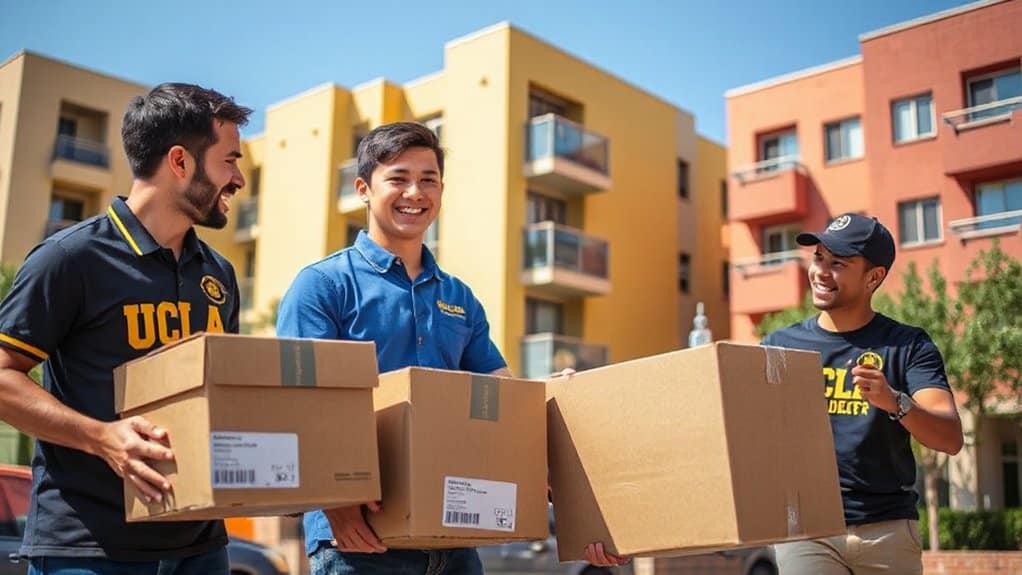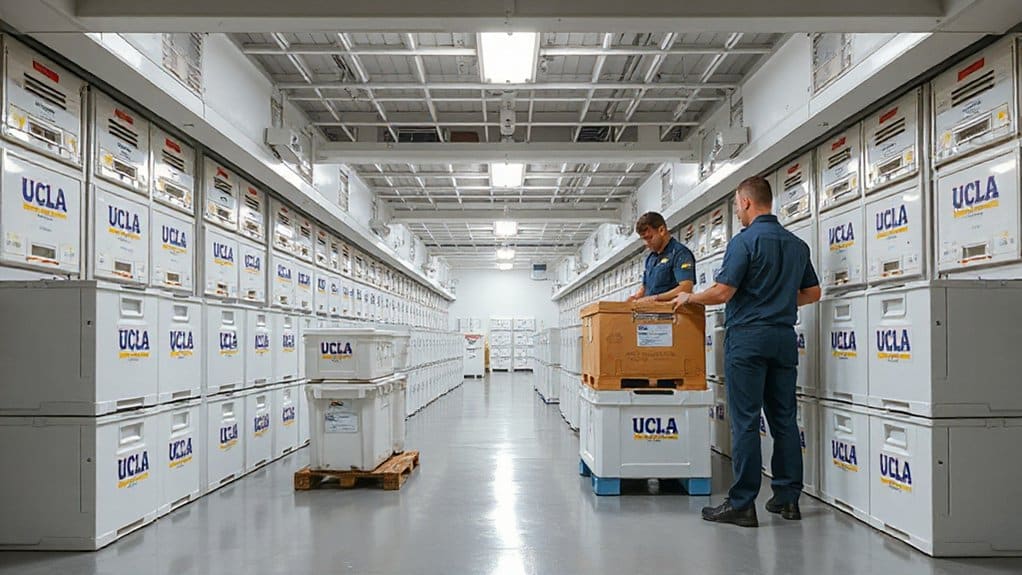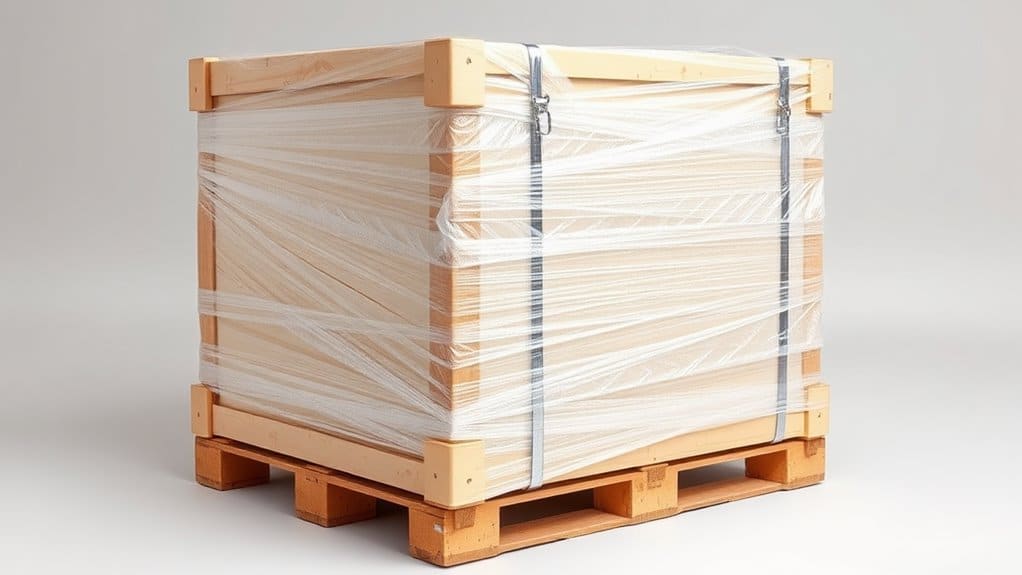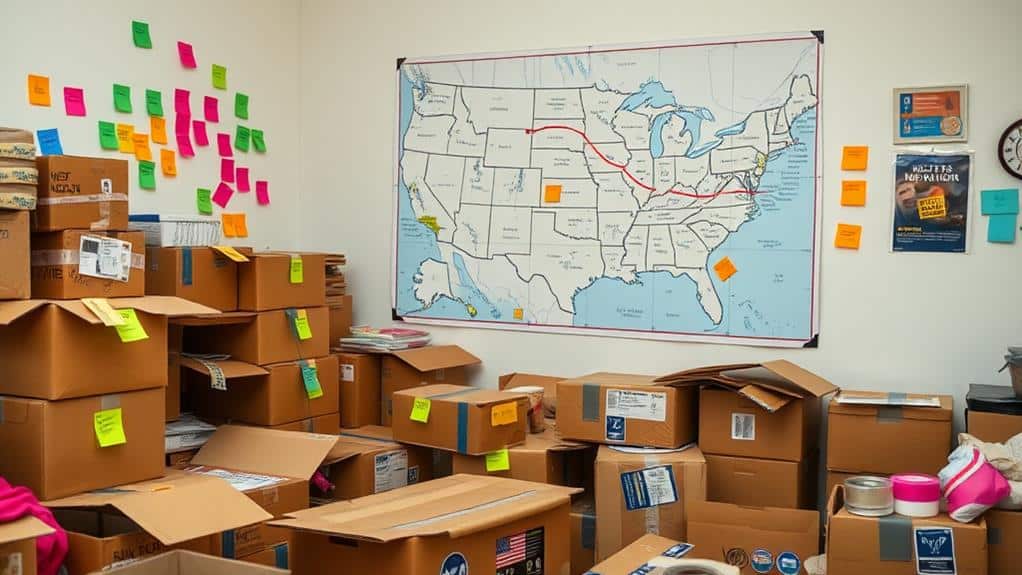Specialized UCLA Academic Moving Routes
At California New York Express, we understand the unique scheduling, logistical, and academic considerations involved in relocating UCLA faculty, researchers, and graduate students. With dedicated routes specifically crafted for the UCLA community, we provide timely, efficient, and stress-free moves that align seamlessly with your academic calendar.

Our Frequent UCLA Relocation Routes Include:
- Moving from UCLA to New York Universities (NYU, Columbia, Cornell, etc.)
- Moving from New York Universities directly to UCLA Campus
- Moving from UCLA to San Francisco-area Universities
- Moving from San Francisco-area Universities to UCLA
Our exclusive focus on California-New York university moves ensures unparalleled quality, consistency, and reliability for the UCLA academic community.
Why UCLA Trusts Our University Moving Service
UCLA consistently chooses California New York Express for cross-country academic moves due to our proven reputation, exceptional customer care, and tailored handling of delicate academic resources. Our experience means your relocation will be smooth, secure, and efficient, minimizing disruption to your UCLA responsibilities.
Industry-Recognized Excellence
Our professional integrity is endorsed by industry leaders in academic relocation and insurance providers, offering UCLA faculty and staff confidence and peace of mind:
- Official letters of recommendation from major insurance companies.
- Partnerships and verified affiliations with Baker International and MovingInsurance.com.
The California New York Express UCLA Advantage
- 100% GUARANTEED PRICING: Transparent, upfront, with no hidden costs.
- GUARANTEED DELIVERY TIMEFRAME: Reliable and predictable scheduling aligned with UCLA’s academic calendar.
- ZERO SUBCONTRACTORS: Fully vetted, professional movers directly employed by us.
- STRATEGIC FACILITIES: Conveniently located near UCLA for efficiency.
- 96% ON-TIME DELIVERY RATE: Proven reliability ensures peace of mind for your move.
Tailored Solutions Specifically for UCLA Faculty & Graduate Students
Our customized UCLA faculty moving services offer comprehensive support, precisely tailored to the specialized needs of faculty and research professionals:
- Professional handling of rare books, archives, and confidential research documents.
- Safe transport and meticulous care of laboratory and sensitive research equipment.
- Customized schedules aligned precisely with UCLA’s academic calendar.
- Assistance in meeting UCLA’s relocation budget compliance guidelines.
- Timely relocations tailored to UCLA tenure-track and faculty appointments.
UCLA Faculty Testimonial:
“As a UCLA professor moving a research lab from Cornell, the care California New York Express showed was exemplary. My sensitive equipment and research samples arrived flawlessly, allowing my work at UCLA to continue uninterrupted.” — Prof. Jennifer Lewis, UCLA Department of Biological Sciences
UCLA Graduate Student Moving Services
We provide budget-conscious, flexible moving solutions designed exclusively for UCLA graduate students, reducing stress and costs:
- Cost-effective shared-load options specifically for graduate moves.
- Flexible scheduling tailored to UCLA graduate academic deadlines.
- Free short-term storage to accommodate graduate housing transitions.
- Academic rush moves for last-minute UCLA appointments and research opportunities.
- Specialized handling of books, technology, and personal belongings.

Top Universities We Proudly Serve
| Top California Universities | Top New York Universities |
|---|
| University of California, Los Angeles (UCLA) | Columbia University |
| Stanford University | New York University (NYU) |
| University of California, Berkeley | Cornell University |
| University of Southern California (USC) | Syracuse University |
| California Institute of Technology (Caltech) | University of Rochester |
| University of California, San Diego (UCSD) | City University of New York (CUNY) |
| University of California, Irvine (UCI) | Rensselaer Polytechnic Institute (RPI) |
| University of California, Santa Barbara (UCSB) | Fordham University |
| University of California, Davis (UCD) | Stony Brook University |
| Pepperdine University | The New School |

Comprehensive UCLA University Moving Services
Transparent & Cost-Effective Academic Pricing
We are committed to transparent and academic-friendly pricing for all UCLA-related relocations:
- Absolutely zero hidden fees or surprise charges.
- Detailed reimbursement documentation compatible with UCLA’s accounting procedures.
- Exclusive discounted rates for UCLA faculty, staff, and graduate students.
- Small academic moves starting at 200-cube minimums.
Flexible UCLA Storage Solutions
Our storage solutions perfectly accommodate UCLA moves:
- Complimentary 30-Day Storage at no additional cost for UCLA moves.
- Climate-controlled, secure storage ideal for sensitive academic equipment and materials.
- Convenient facility locations near UCLA for easy access.
- Flexible long-term storage extensions upon request.
Professional Packing & Handling of UCLA Academic Materials
We provide expert packing and handling for all UCLA relocations, ensuring your valuable academic materials arrive safely:
- Custom crating for laboratory, medical, or specialized research equipment.
- Specialized packing methods for books, archives, and sensitive documents.
- Safe, professional transport of delicate electronics and academic technology.
- Fine art and artifacts handled by professional art movers.
UCLA Moving Tips & Resources
Academic Moving Timeline
- 8-10 Weeks Before Move: Begin detailed UCLA relocation planning, budgeting, and storage preparations.
- 4-6 Weeks Before Move: Organize and pack critical academic resources, coordinate with UCLA departments.
- 2-3 Weeks Before Move: Confirm final logistics, complete detailed moving checklist.
UCLA Housing Resources
- Detailed UCLA campus housing move-out and move-in procedures.
- Faculty housing guidelines and available assistance programs.
- Coordination and assistance securing off-campus UCLA housing.
- Temporary and transitional housing solutions close to UCLA campus.

UCLA Academic Moving FAQs
How early should I book my UCLA relocation services?
To ensure availability and a smooth relocation process, it's advisable to book your moving services as early as possible. This allows ample time for planning and coordination, especially during peak moving seasons.
Will UCLA reimburse relocation expenses for faculty and graduate researchers?
Yes, UCLA offers relocation expense reimbursements for eligible new appointees to academic positions. Relocation expenses are defined as the reasonable costs of moving household goods and personal effects to a new residence. The Chancellor’s Office reimburses the first 50% of allowable expenses, with the Dean’s advance approval required. Additionally, the Chancellor’s Office reimburses 100% for the removal of an office, lab, or library, provided these are made available to students and other faculty members on campus.
How long is a typical relocation from UCLA to New York-based universities?
The duration of a move from Los Angeles to New York City typically depends on various factors, including the specific services selected and scheduling. For precise timelines, it's best to consult directly with California New York Express Movers.
Can you handle highly specialized UCLA academic and laboratory equipment?
Yes, California New York Express Movers is equipped to handle specialized academic and laboratory equipment. We understand the importance of such items and employ trained professionals to ensure their safe and secure transport.
Are there special discounts provided for UCLA community members?
While specific discounts for UCLA community members are not mentioned on our website, we encourage you to contact us directly to inquire about any available promotions or discounts. Our team is committed to providing competitive rates and exceptional service.
How does the complimentary 30-day storage solution specifically benefit UCLA relocations?
Our complimentary 30-day storage solution offers flexibility during your move. Whether you need temporary storage due to overlapping leases or require additional time to settle into your new space, this service ensures your belongings are securely stored at no extra cost for the first 30 days.
For more detailed information or to discuss your specific relocation needs, please contact California New York Express Movers at (888) 680-7200 or visit our website at moveeast.com.
Ready for Your UCLA Cross-Country Move Between California & New York?
Since 1995, California New York Express has been the trusted choice of the UCLA community for specialized cross-country academic moves. Our expertise, meticulous care, and academic-centric approach ensure a stress-free relocation, allowing you to fully focus on your academic pursuits at UCLA.
Get Started Today. Call: (888) 680-7200












